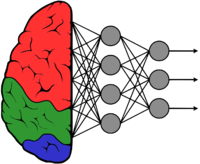GstInference Classification application
Make sure you also check GstInference's companion project: R2Inference |
This example receives an input video file and classifies each frame into one of the 1000 possible classes. For each classified frame, the application captures the signal emitted by GstInference, forwarding the prediction to a placeholder for external logic. Simultaneously, the pipeline displays the captured frames with the associated label in a window. Note that the image currently being displayed not necessarily matches the one being handled by the signal. The display is meant for visualization and debugging purposes.
The classification architecture being used by the example is InceptionV4 trained using the Large Scale Visual Recognition Challenge 2012 (ILSVRC2012) Dataset. A pre-trained model can be downloaded from the GstInference Model Zoo
This examples serves both as an example and as a starting point for a classification application.
Contents
Building the Example
The example builds along with the GstInference project. Make sure you follow the instructions in Building the Plug-In to make sure all the dependencies are correctly fulfilled.
Once the project is built the example may be built independently by running make within the example directory.
1 cd tests/examples/classification
2 make
The example is not meant to be installed.
Running the Example
The classification application provides a series of cmdline options to control the behavior of the example. The basic usage is:
./classification -m MODEL -f FILE -b BACKEND [-v]
- -m|--model
- Mandatory. Path to the InceptionV4 trained model
- -f|--file
- Optional. Path to the video file to be used.
- If it is not set, a camera stream will be used.
- -b|--backend
- Mandatory. Name of the backend to be used. See Supported Backends for a list of possible options.
- -v
- Optional. Run verbosely.
You may always run --help for further details.
./classification --help
Usage:
classification [OPTIONS] - GstInference Classification Example
Help Options:
-h, --help Show help options
--help-all Show all help options
--help-gst Show GStreamer Options
Application Options:
-v, --verbose Be verbose
-m, --model Model path
-f, --file File path
-b, --backend Backend used for inference, example: tensorflow
Extending the Application
The example is composed of the following main files:
- gstclassification.c
- Source file with GStreamer logic
- customlogic.c
- Placeholder for custom logic
- customlogic.h
- Header file for custom logic source
- Makefile
- Build script
- classification
- Executable generated on build
The application can be extended by filling in the placeholders in customlogic.c. In the most simple cases, the information provided in handle_predictionshould suffice to react to the prediction.
1 void
2 handle_prediction (unsigned char *image,
3 int width,
4 int height,
5 int size,
6 double *probabilities,
7 int num_probabilities)
8 {
9 /* FILLME: Handle image and prediction here */
10 }
- image
- Image data in RGB raster format.
- width
- The width of the image, in pixels
- height
- The height of the image, in pixels
- size
- The size of the total image, in bytes
- probabilities
- An array of probabilities for each class
- num_probabilities
- The length of the probabilities array
The signal will block buffer streaming. Long processing operations should perform asynchronously to avoid blocking the pipeline |
Troubleshooting
The first debug level is GStreamer debug. You may execute the application with debug enabled by running:
1 ./classification --gst-debug=2
For advanced support, please contact [1] with the output of the following command:
1 ./classification --gst-debug=2,videoinference:6,inceptionv4:6
Reporting a Bug
Please feel free to report bugs using GitHub's issue tracker.

